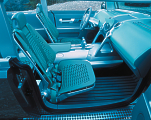
.
. .
..
. . .
DaimlerChrysler 2003 Concepts: DaimlerChrysler 2002 Concepts: DaimlerChrysler 2001 Concepts:
© 1999-2005
Copyright |
DaimlerChrysler: The Jeep Willys Concept “Pure American” Jeep® Design The back-to-basics, composite-bodied Jeep® Willys concept vehicle pays homage to Jeep vehicles of the past while showcasing the design and technology of the 21st century.
The Willys, unveiled at the 2001 North American International Auto Show in Detroit, features plastic body-technology, allowing for a radical approach to Jeep design while remaining true to the brand’s legendary capability. Shown in several concept vehicles designed by the Chrysler Group, injection-molded plastic bodies save up to 50 percent in weight and manufacturing costs and are nearly 100 percent recyclable. The molded-in-color plastic allows designers to create shapes not permitted with stamped metal, such as the crisp, rigid lines that give the Willys its high-tech, machined appearance. The Jeep Willys’ lightweight aluminum frame-web is similar to technologies found in today’s top performance sports and military equipment. While its battle-proven, World War II ancestor was made of sheet metal, this concept was built in carbon fiber to simulate the weight savings that could be achieved with injection-molded plastics. Frame-web technology molds the one-piece carbon fiber body to an aluminum frame, giving the Jeep Willys industry-leading rigidity. Designed with a sense of adventure, the Willys creates a fresh, ultra-modern interpretation of the legendary Jeep brand. Confidence-inspiring shapes such as the seven-slot grille, the uniquely executed wheel arches, the extremely short rear and the vehicle’s athletic stance maintain true Jeep character. Willys’ chiseled body lends substance and visual weight, suggesting a low center of gravity with a long wheelbase (95 inches/2413 mm) and wide track (58.9 inches/1496 mm front, 59.4 inches/1509 mm rear). The 2,900-pound (1315 kg) curb weight of the Jeep Willys allows a 15:1 weight-to-horsepower ratio. “My ‘pure American’ design philosophy for the Jeep Willys led me to the very clean, precise and mechanical appearance,” said Jordan Meadows, Product Designer at DaimlerChrysler’s Pacifica Design Center in Carlsbad, Calif. “However, it still shows traditional Jeep design cues, such as the trademark grille and wheel arches and its commanding feel on the road, as well as off the beaten path.” This visual character is carried on in the interior. Willys’ spacious interior sports a light palette in colors and materials. Featured are brushed aluminum and aqua and grey leather with Starbrite Silver accents. “In detailing Willys’ interior with an honest look and feel, we reinforced the versatile Jeep lineage,” said Meadows. “The Jeep Willys is a prime example of a vehicle embracing its past while looking to its future.” Emphasizing the combination of heritage and modern technology, the concept comes equipped with a Sirius Satellite Radio. It offers digital quality audio with crystal clear reception coast-to-coast from more than 100 news, sports and entertainment channels, of which 50 music channels are commercial-free. The Jeep Willys is powered by DaimlerChrysler’s 1.6-liter, in-line four-cylinder engine that has been supercharged to deliver 160 horsepower (120 kW) and 155 lb.-ft. of torque (210 N•m). Its four-speed automatic transmission is coupled with a shift-on-the-fly transfer case with full-time four-wheel drive and low-range modes. Custom, independent short-and-long-arm front and multi-link solid rear axle suspension with coil-over-shock set-up and sizeable 22-inch wheels with P235/840R560 PAX tires embraces the “go anywhere” attitude synonymous with the Jeep brand. Estimated performance figures include a sprint to 60 mph. (97 kph) in 10.2 seconds and a top speed of almost 90 mph. (140 kph). “The custom suspension and supercharged powertrain were engineered to preserve the rugged capabilities that the Jeep brand is known for,” added Creed. “We wanted the DNA of the Willys to speak to the heritage of its ancestors. We were looking for the most efficient yet stylish way to capture the spirit of classic Jeep vehicles enhanced with modern technology. Marrying 21st century technology with 20th century tradition, the pure American Willys captures the bare essence of the Jeep brand." All pictures: Chrysler
|
.
|
















